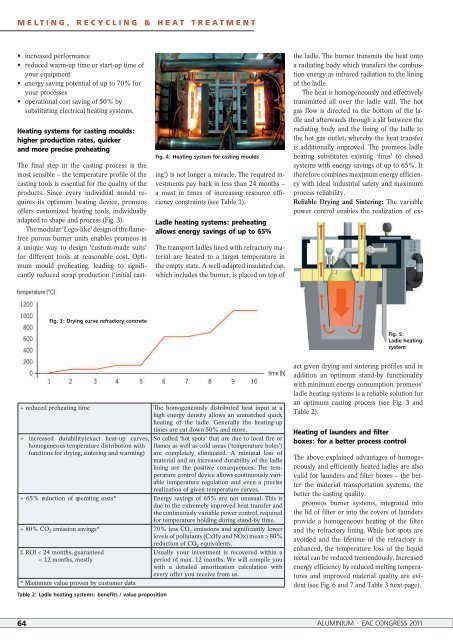Influence of the natural aluminium oxide layer on ... - ALU-WEB.DE
Influence of the natural aluminium oxide layer on ... - ALU-WEB.DE
Influence of the natural aluminium oxide layer on ... - ALU-WEB.DE
You also want an ePaper? Increase the reach of your titles
YUMPU automatically turns print PDFs into web optimized ePapers that Google loves.
MELTING, RECYCLING & HEAT TREATMENT<br />
• increased performance<br />
• reduced warm-up time or start-up time <str<strong>on</strong>g>of</str<strong>on</strong>g><br />
your equipment<br />
• energy saving potential <str<strong>on</strong>g>of</str<strong>on</strong>g> up to 70% for<br />
your processes<br />
• operati<strong>on</strong>al cost saving <str<strong>on</strong>g>of</str<strong>on</strong>g> 50% by<br />
substituting electrical heating systems.<br />
Heating systems for casting moulds:<br />
higher producti<strong>on</strong> rates, quicker<br />
and more precise preheating<br />
The final step in <str<strong>on</strong>g>the</str<strong>on</strong>g> casting process is <str<strong>on</strong>g>the</str<strong>on</strong>g><br />
most sensible – <str<strong>on</strong>g>the</str<strong>on</strong>g> temperature pr<str<strong>on</strong>g>of</str<strong>on</strong>g>ile <str<strong>on</strong>g>of</str<strong>on</strong>g> <str<strong>on</strong>g>the</str<strong>on</strong>g><br />
casting tools is essential for <str<strong>on</strong>g>the</str<strong>on</strong>g> quality <str<strong>on</strong>g>of</str<strong>on</strong>g> <str<strong>on</strong>g>the</str<strong>on</strong>g><br />
products. Since every individual mould requires<br />
its optimum heating device, promeos<br />
<str<strong>on</strong>g>of</str<strong>on</strong>g>fers customized heating tools, individually<br />
adapted to shape and process (Fig. 3).<br />
The modular ‘Lego-like’ design <str<strong>on</strong>g>of</str<strong>on</strong>g> <str<strong>on</strong>g>the</str<strong>on</strong>g> flamefree<br />
porous burner units enables promeos in<br />
a unique way to design ‘custom-made suits’<br />
for different tools at reas<strong>on</strong>able cost. Opti-<br />
mum mould preheating, leading to significantly<br />
reduced scrap producti<strong>on</strong> (‘initial cast-<br />
Fig. 3: Drying curve refractory c<strong>on</strong>crete<br />
+ reduced preheating time The homogeneously distributed heat input at a<br />
high energy density allows an unmatched quick<br />
heating <str<strong>on</strong>g>of</str<strong>on</strong>g> <str<strong>on</strong>g>the</str<strong>on</strong>g> ladle. Generally <str<strong>on</strong>g>the</str<strong>on</strong>g> heating-up<br />
times are cut down 50% and more.<br />
+ increased durability(exact heat-up curves,<br />
homogeneous temperature distributi<strong>on</strong> with<br />
functi<strong>on</strong>s for drying, sintering and warming)<br />
So called ‘hot spots’ that are due to local fire or<br />
flames as well as cold areas (‘temperature holes’)<br />
are completely eliminated. A minimal loss <str<strong>on</strong>g>of</str<strong>on</strong>g><br />
material and an increased durability <str<strong>on</strong>g>of</str<strong>on</strong>g> <str<strong>on</strong>g>the</str<strong>on</strong>g> ladle<br />
lining are <str<strong>on</strong>g>the</str<strong>on</strong>g> positive c<strong>on</strong>sequences. The temperature<br />
c<strong>on</strong>trol device allows c<strong>on</strong>tinuously variable<br />
temperature regulati<strong>on</strong> and even a precise<br />
realizati<strong>on</strong> <str<strong>on</strong>g>of</str<strong>on</strong>g> given temperature curves.<br />
+ 65% reducti<strong>on</strong> <str<strong>on</strong>g>of</str<strong>on</strong>g> operating costs* Energy savings <str<strong>on</strong>g>of</str<strong>on</strong>g> 65% are not unusual. This is<br />
due to <str<strong>on</strong>g>the</str<strong>on</strong>g> extremely improved heat transfer and<br />
<str<strong>on</strong>g>the</str<strong>on</strong>g> c<strong>on</strong>tinuously variable power c<strong>on</strong>trol, required<br />
for temperature holding during stand-by time.<br />
+ 80% CO 2 emissi<strong>on</strong> savings* 70% less CO 2 emissi<strong>on</strong>s and significantly lower<br />
levels <str<strong>on</strong>g>of</str<strong>on</strong>g> pollutants (CxHy and NOx) mean > 80%<br />
reducti<strong>on</strong> <str<strong>on</strong>g>of</str<strong>on</strong>g> CO 2 equivalents.<br />
Σ ROI < 24 m<strong>on</strong>ths, guaranteed<br />
< 12 m<strong>on</strong>ths, mostly<br />
* Maximum value proven by customer data<br />
Table 2: Ladle heating systems: benefits / value propositi<strong>on</strong><br />
Fig. 4: Heating system for casting moulds<br />
ing’) is not l<strong>on</strong>ger a miracle. The required investments<br />
pay back in less than 24 m<strong>on</strong>ths –<br />
a must in times <str<strong>on</strong>g>of</str<strong>on</strong>g> increasing resource efficiency<br />
c<strong>on</strong>straints (see Table 1).<br />
Ladle heating systems: preheating<br />
allows energy savings <str<strong>on</strong>g>of</str<strong>on</strong>g> up to 65%<br />
The transport ladles lined with refractory material<br />
are heated to a target temperature in<br />
<str<strong>on</strong>g>the</str<strong>on</strong>g> empty state. A well-adapted insulated cap,<br />
which includes <str<strong>on</strong>g>the</str<strong>on</strong>g> burner, is placed <strong>on</strong> top <str<strong>on</strong>g>of</str<strong>on</strong>g><br />
Usually your investment is recovered within a<br />
period <str<strong>on</strong>g>of</str<strong>on</strong>g> max. 12 m<strong>on</strong>ths. We will compile you<br />
with a detailed amortizati<strong>on</strong> calculati<strong>on</strong> with<br />
every <str<strong>on</strong>g>of</str<strong>on</strong>g>fer you receive from us.<br />
<str<strong>on</strong>g>the</str<strong>on</strong>g> ladle. The burner transmits <str<strong>on</strong>g>the</str<strong>on</strong>g> heat <strong>on</strong>to<br />
a radiating body which transfers <str<strong>on</strong>g>the</str<strong>on</strong>g> combusti<strong>on</strong><br />
energy as infrared radiati<strong>on</strong> to <str<strong>on</strong>g>the</str<strong>on</strong>g> lining<br />
<str<strong>on</strong>g>of</str<strong>on</strong>g> <str<strong>on</strong>g>the</str<strong>on</strong>g> ladle.<br />
The heat is homogeneously and effectively<br />
transmitted all over <str<strong>on</strong>g>the</str<strong>on</strong>g> ladle wall. The hot<br />
gas flow is directed to <str<strong>on</strong>g>the</str<strong>on</strong>g> bottom <str<strong>on</strong>g>of</str<strong>on</strong>g> <str<strong>on</strong>g>the</str<strong>on</strong>g> ladle<br />
and afterwards through a slit between <str<strong>on</strong>g>the</str<strong>on</strong>g><br />
radiating body and <str<strong>on</strong>g>the</str<strong>on</strong>g> lining <str<strong>on</strong>g>of</str<strong>on</strong>g> <str<strong>on</strong>g>the</str<strong>on</strong>g> ladle to<br />
<str<strong>on</strong>g>the</str<strong>on</strong>g> hot gas outlet, whereby <str<strong>on</strong>g>the</str<strong>on</strong>g> heat transfer<br />
is additi<strong>on</strong>ally improved. The promeos ladle<br />
heating substitutes existing ‘fires’ to closed<br />
systems with energy savings <str<strong>on</strong>g>of</str<strong>on</strong>g> up to 65%. It<br />
<str<strong>on</strong>g>the</str<strong>on</strong>g>refore combines maximum energy efficiency<br />
with ideal industrial safety and maximum<br />
process reliability.<br />
Reliable Drying and Sintering: The variable<br />
power c<strong>on</strong>trol enables <str<strong>on</strong>g>the</str<strong>on</strong>g> realizati<strong>on</strong> <str<strong>on</strong>g>of</str<strong>on</strong>g> ex-<br />
Fig. 5:<br />
Ladle heating<br />
system<br />
act given drying and sintering pr<str<strong>on</strong>g>of</str<strong>on</strong>g>iles and in<br />
additi<strong>on</strong> an optimum stand-by functi<strong>on</strong>ality<br />
with minimum energy c<strong>on</strong>sumpti<strong>on</strong>. promeos’<br />
ladle heating systems is a reliable soluti<strong>on</strong> for<br />
an optimum casting process (see Fig. 3 and<br />
Table 2).<br />
Heating <str<strong>on</strong>g>of</str<strong>on</strong>g> launders and filter<br />
boxes: for a better process c<strong>on</strong>trol<br />
The above explained advantages <str<strong>on</strong>g>of</str<strong>on</strong>g> homogeneously<br />
and efficiently heated ladles are also<br />
valid for launders and filter boxes – <str<strong>on</strong>g>the</str<strong>on</strong>g> better<br />
<str<strong>on</strong>g>the</str<strong>on</strong>g> material transportati<strong>on</strong> systems, <str<strong>on</strong>g>the</str<strong>on</strong>g><br />
better <str<strong>on</strong>g>the</str<strong>on</strong>g> casting quality.<br />
promeos burner systems, integrated into<br />
<str<strong>on</strong>g>the</str<strong>on</strong>g> lid <str<strong>on</strong>g>of</str<strong>on</strong>g> filter or into <str<strong>on</strong>g>the</str<strong>on</strong>g> covers <str<strong>on</strong>g>of</str<strong>on</strong>g> launders<br />
provide a homogeneous heating <str<strong>on</strong>g>of</str<strong>on</strong>g> <str<strong>on</strong>g>the</str<strong>on</strong>g> filter<br />
and <str<strong>on</strong>g>the</str<strong>on</strong>g> refractory lining. While hot spots are<br />
avoided and <str<strong>on</strong>g>the</str<strong>on</strong>g> lifetime <str<strong>on</strong>g>of</str<strong>on</strong>g> <str<strong>on</strong>g>the</str<strong>on</strong>g> refractory is<br />
enhanced, <str<strong>on</strong>g>the</str<strong>on</strong>g> temperature loss <str<strong>on</strong>g>of</str<strong>on</strong>g> <str<strong>on</strong>g>the</str<strong>on</strong>g> liquid<br />
metal can be reduced tremendously. Increased<br />
energy efficiency by reduced melting temperatures<br />
and improved material quality are evident<br />
(see Fig. 6 and 7 and Table 3 next page).<br />
64 <strong>ALU</strong>MINIUM · EAC CONGRESS 2011
















